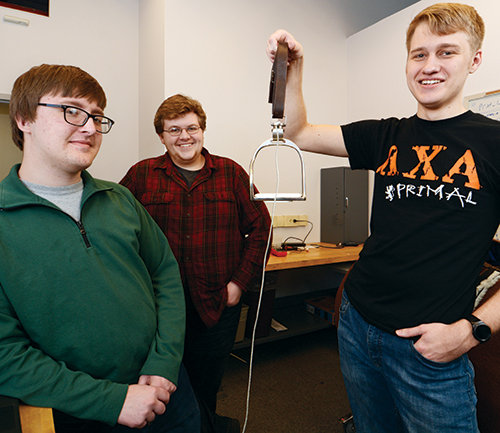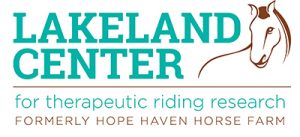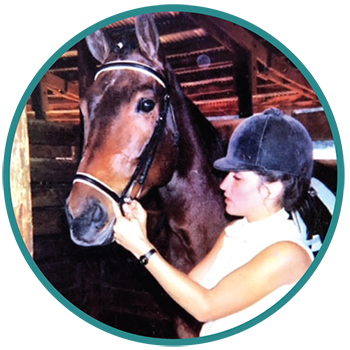
Rose-Hulman Institute of Technology biomedical engineering seniors, from left, Stefanie Panzenhagen, Jordan Hagood, Changlin Shen and Benjamin Stone developed a riding pad with 16 sensors to measure a horseback therapy rider’s weight distribution. The sensors are wired to a circuit board (in Stone’s hand) which processes the sensor data. The circuitry lets instructors know immediately through color-coded LEDs on the back of the pad whether the rider is applying more pressure to either side or is balanced on the horse. A computer app the team also developed translates the sensor data into measurable documentation that can track how a rider is progressing. The pad is one of several projects RHIT students developed this year for the Lakeland Center for Therapeutic Riding and Research.
Photo by Richard G. Biever
For 17 seasons, Christy Menke’s Hope Haven Horse Farm helped kids and adults with special needs and injuries find relief from their challenges.
When clients begin returning this month for the 2018 season, they will find a new name out front and a new emphasis on trail-blazing technology to help them even more when they get back in the saddle. Hope Haven, a nonprofit riding facility in southwest Hendricks County, has rebranded itself as Lakeland Center for Therapeutic Riding Research.

Christy Menke and her world-class jumping horse, Lakeland, are shown in an old snapshot from about 20 years ago. She said the “fire-breathing” horse had a knack of forming special bonds with people with special needs. Though Lakeland died in 2005, his spirit is the inspiration for Menke’s
nonprofit therapeutic riding center that rebranded itself from Hope Haven to Lakeland Center last fall.
While it will always be a place of hope, the therapeutic farm has set a higher fence to jump — to move beyond being merely a “haven” or a refuge. Lakeland Center is striving to fuse horseback therapy with new and innovative electronic and mechanical devices being developed in collaboration with biomedical engineering students at Rose-Hulman Institute of Technology. Along with vastly improving the therapy riders receive, the emerging projects are capable of providing standardized physiological feedback — the tangible, medical proof — that equine therapy does what it’s supposed to do.
“As professionals, we see the difference therapeutic riding makes. I can see that clients are getting better, but the part of the world that needs to support this, can’t,” Menke said.
“Insurance companies want data, data, data,” added Christy Whiteside, who is the newest instructor at the center. “There’s no reason why therapeutic riding — what we’re doing — shouldn’t be covered by insurance.”
But both Christys admit it’s hard for insurance to cover equine therapy since “industry standards” vary widely around the country and even from therapy center to center within the state. Every center may use a different system to set client goals, define success and document it.
“Our vision is that the data we collect will provide the scientific measurements needed to increase resources for those we serve in therapy lessons and improve the industry as a whole,” Menke said.
A horse’s gait
Horses have been used in forms of therapy as far back as the ancient Greeks. But only in the last 60-70 years has modern equine therapy taken off. The practice started in Europe and came to the United States and Canada shortly after.

Alison Garceau works on her balance while riding a mule at the indoor arena at Lakeland Center last month. Assisting her are, from right, Christy Menke, who founded Lakeland Center 18 years ago; Christy Whiteside, an instructor; and Arrin Halcomb, a riding client at the center who is rehabbing her reconstructed ankle and volunteering as an assistant.
Horseback riding is beneficial to people who cannot walk or have trouble walking because a horse’s four-beat gait mimics human walking. The horse’s movements stimulate and work the same muscles in the rider’s pelvic area and lower back that the person would use if he or she were actually walking.
Riding has been shown to help people with autism, ADD/ADHD, Down syndrome, cerebral palsy, learning and cognitive disorders, traumatic brain injury, and ambulatory, neurological, orthopedic and comorbid challenges.
Riding has been shown to improve posture, mobility, flexibility, balance, strength, fine and gross motor skills, confidence, coordination, endurance, cardiovascular and respiratory function and even interpersonal relationships.
A haven in Indiana
The 48-year-old Menke has been around horses most of her life. In the late 1980s and 90s, she was a rising equestrian on the jumping circuit along the East Coast. With her world-class show horse, Lakeland, she was hoping to reach the equestrian Grand Prix.
Then, she suffered a back injury in a car accident which nipped her career. In 2000, at the invitation of her grandparents, she returned to her Indiana roots with her daughter and Lakeland, whose spirit became the inspiration for the rebranded center. (Please see side bar below.)
On 10 acres of her grandfather’s farmland and with the help of her mom, grandfather and relatives in Hendricks and Putnam counties, she launched Hope Haven. “I wanted it to be family oriented, and what we have here is very special,” she said. “We don’t just do the lessons, we sit with the families afterward whether it’s music or whether it’s just laughing. But we want to make a difference.”
Though Hope Haven grew to over 200 clients and a dozen horses, Menke said something was missing. “I just felt it wasn’t doing what it needed to do.”
Toward that end, Menke went to nursing school about eight years ago and became a registered nurse to add a medical background to further assist clients. But the biggest change to the farm and its future came with a new riding client at about the same time.
New connections
Drew Christy had been a Rose-Hulman biomedical engineering student, football player and 2006 Hendricks Power Cooperative scholarship winner who grew up nearby in southern Putnam County. In February 2008, the sophomore suffered a traumatic brain injury when his car slid off an icy U.S. 40 while he drove home from Rose-Hulman. For five months, he was in a coma. His doctors gave him a 1 percent chance of survival.

Another team of Rose-Hulman biomedical engineering students, Matthew Davis, from left, Colton Watson and Chris Hockaden, displays a stirrup the three have worked on along with its interfacing circuitry and software. The stirrup measures the force being applied by the rider’s foot as it sits in the stirrup and will be able to tell therapists the rider’s balance and pressure the rider is able to apply. The team upgraded the special stirrup that Rose-Hulman students originally developed two years ago.
But Drew survived, emerged from the coma and slowly and persistently began to work on rehabilitation. Biomed engineering students at Rose-Hulman helped by developing and refining therapy equipment for him to use at home.
By May 2012, Drew had regained enough strength and mobility to begin equine therapy at Hope Haven. His mom reached out to Rose-Hulman professors to see if students could also assist with devices to help riders there. Rose-Hulman jumped at the opportunity.
“We owe this new journey to the Christy family,” Menke said. “Drew gave us so much inspiration and paved the way for many to follow. The collaboration with Rose-Hulman would have never happened without Drew and his mom and dad, Debbi and Mark Christy.”
That first year, 12 Rose-Hulman students came to Hope Haven to work on their senior “capstone projects” which they renamed “Christy projects” in honor of Drew and Menke. Projects included an electronic horse simulator to replicate the beneficial equine movement for clients unable to ride a full-sized animal or limited by time and location; equipment that helped support and balance riders on a horse; and more.
Menke immediately realized incorporating the new technology into the riding lessons and therapy vastly improved clients’ experiences. Clients became stronger and were able to move more quickly to the next level of therapy.
The prototypes also provided biofeedback data on the physical and cognitive status of the riders. That measurable feedback is the Holy Grail needed to advance therapeutic riding.
“All the puzzle pieces started coming together at the same time,” Menke said of her nursing degree and the research and feedback brought in by Rose-Hulman.
“What I’ve learned from nursing school and from being a nurse is the rationale. I need rationale for why we’re doing things. All the statistics, all the things we’re doing now are the same things hospitals are doing.”
Back in the saddle
Arrin Halcomb wanted a horse as far back as she could remember. “That’s what I asked for every year for my birthday,” she said. “But we lived in the city, so we didn’t have any place to put it.”

Arrin Halcomb gives a hug to Dudley, the horse she rides at Lakeland Center for Therapeutic Riding and Research. Arrin, who suffered injuries to her right ankle while cheerleading, rides to provide therapy for her foot and her emotions.
When her family did move to four acres in rural Hendricks County some seven years ago, she was getting into gymnastics — which led to competitive cheerleading. “I had a pretty great sport that I loved,” the 16-year-old Cascade High School sophomore said. “I really didn’t need a horse.”
Then, her right ankle sustained a series of devastating injuries — torn tendons and ligaments — requiring two reconstructive surgeries and the insertion of three rods. Arrin was left with only partial feeling in her right foot and was no longer able to compete in cheerleading.
That’s when horses re-entered her dreams.
She and her family started therapy riding at Hope Haven for her physical and emotional pain caused by the chronic ankle injury.
Once Arrin started riding, she realized her injury also limited her there. “I couldn’t feel how much I was pushing,” she said of using her right foot in the stirrup to help direct the horse, “or if I was even pushing at all.”
Riding and now also volunteering at the farm helped Arrin regain feeling: both in her foot and with her emotions. “I’m surprised at how much it’s helped, especially not just my ankle. I suffer from depression and anxiety, too,” she said. “Coming here with all the positivity and all the laughter, it’s really helped.”
While she’s learned techniques to help overcome the foot issue, one of the projects Rose-Hulman students will unveil this month will help even more. It’s an upgraded pressure-monitoring stirrup. “I’m really excited for the new stirrup because it’s really going to be able to show how much pressure is there,” Arrin said.
Bringing it home
Also excited to see the new stirrup in use is the Rose-Hulman team that worked on it this year. “It’s a feeling of accomplishment that we designed this, and we went out and built it,” said Chris Hockaden, a senior from Greensburg. “The hands-on experience of actually building it is one of the best parts.”
“That brings it home,” added Menke, “when they see somebody using it.”

Christy Menke, left, and Christy Whiteside lead Alison Garceau through a series of warm-up stretching and strength exercises on a mechanical horse before taking the 38-year-old riding on a live animal. The mechanical horse simulates the back movements of a real horse as it walks. It was an earlier Rose-Hulman student project for Lakeland Center, then known as Hope Haven. The farm, southwest of Indianapolis, is served electrically by Hendricks Power Cooperative.
“Our hope would be that we help individual clients at Christy’s farm just get better. That’s the first goal,” said Stefanie Panzehagen, a senior from New Berlin, Wisconsin. She was part of a team developing a riding pad with pressure sensors and LED lights that measure a rider’s balance and tells instructors when balance is shifting. “Going from there,” she added, “hopefully it can be used in more applications and for more people to spread the impact.”
Menke said the technology will change the therapeutic riding nationwide. Besides improving therapy for riders and providing data for insurance, the technology offers more opportunities for people to participate and help instructors improve techniques.
“Not everybody can come and do therapeutic riding. They may have asthma. They may be in a hospital. It may be too far to drive,” Menke said. “Now that we have a simulator, we will be the first mobile unit. We don’t want to take away the warm fuzzy of the horses, but these are ways to reach hundreds and hundreds and hundreds of clients.”
She said the technology has already paid dividends in the long-term health of clients, too.
One rider, with a diagnosis of autism, could not speak or communicate well, but she always rode straight in the saddle. Then, her instructors began noticing her leaning forward more, but they could not pinpoint why.
Menke said at the same time, they were working also with occupational therapy students from Indiana State University on a balance study. Using the Rose-Hulman technology of saddle and stirrup sensors along with the ISU balance team’s documentation, they found the rider had a discrepancy in leg length and an uneven pelvis on both the horse simulator and live horse.
“Everything is telling us what’s going on with her. She can’t tell us. Even with our expertise, we can’t see what her hip or the stirrup pressures are telling us,” Menke said. “We were able to tell her agency to look at her hips. Now, we’ve got the technology to find diagnostic problems that can be fixed before they get to the point they are going to need surgery.”
“This was my ‘aha’ moment … giving me hope for a new era of therapeutic riding,” she added. “The information from the data we are retrieving is astonishing, and we continue to learn every time we utilize it. The research avenues are endless at this point.”
But even with the added technology, Menke hasn’t lost sight of the reason she and so many other horse therapy centers do what they do. That’s providing the emotional connection between riders and horses; that “warm fuzzy” she spoke of.
An example of this, Menke said, involved a woman who became a quadriplegic at age 16 after a vehicle accident. She came to the horse farm in her 20s. One of her favorite memories of her life before the accident was riding a horse, but she thought she’d never ride again. Instructors and volunteers worked together to put her back in the saddle.
“These are the tearful moments,” Menke added. “When someone who’s been in a car accident and is a quadriplegic says, ‘I’m on a horse! I’m on a horse!’ And the whole arena just starts crying because she never thought she’d ever be able to do that again. It gave her legs.
“Those are the moments we live for.”
RICHARD G. BIEVER is senior editor of Electric Consumer.
Lakeland’s word
Center’s namesake had a way with people with special needs
Christy Menke first saw equine therapy work its magic when she was riding on the competitive jumping circuit in the early 1990s. In a poignant, personal way, it seared a lasting impression in her mind that became her lifelong passion. And it didn’t even involve riding.
Lakeland was her world-class jumper, “a fire-breathing dragon” that could leap 5-foot, 6-inch fences. “He wanted it known that it was his world,” Menke said. “He lived in padded stalls. If he didn’t like you, his ears would go flat back, and he’d run at you.”
One group Lakeland particularly disliked was “the foo-foo girls,” as Menke called them. These were the girls at the stable she managed near Atlanta who were too big for their expensive riding britches, spoke in loud voices and surrounded themselves in adolescent drama. “Those girls would come through,” she said, “and he’d pound that door. He would charge it, and his water bucket would be flying….”
Behind the farm was a low-rent trailer park. Jennifer, a teenage girl with a learning disability, lived there. Menke hired her to come in, feed the horses and clean the stalls. When she would, Menke noticed she always kept her long sleeves down.
One day, Menke came into the stable, and Lakeland was being uncharacteristically quiet. “You could hear all the little foo-foo girls walking through. He’s not charging. He’s not doing any of those crazy things.
“So, I peeked around the corner, and this little girl from the trailer park with the learning disability and the ratty clothes who only shoveled poop was in there hugging him, and she was crying. And his neck had gone over her and was squeezing her.
“I just stood there.
“She had taught him to bow. She was in the stall, and she had him bowing!”
As Jen hugged Lakeland, her sleeves slid up her arm. For the first time, Menke also saw why she kept them down. “I could see all the bruises. I can see the beatings, the burns, all that.”
Menke sought help for Jen with her home life, and began giving her riding lessons. To the chagrin of the foo-foo girls who all wanted to ride Lakeland, the highest jumper in the stable, Jen was the only other person allowed to ride Menke’s horse.
“Show jumpers, they’re wild. They are hard to ride,” Menke continued. “When she got on him, he was like a plow horse. He just babysat her. If she started to shift her weight, he’d stop. If something was wrong, he’d stop. His complete demeanor changed when this child was around him. Lakeland gave her the power to seek out the help she needed. She had the confidence through Lakeland to know that she was somebody.”
Lakeland, the feisty, striding, German Warmblood with a tender side, showed Menke the difference a special horse could make in a troubled child’s life. That planted the seed that became Hope Haven — which is now the center for riding and research that bears his name.
 For more info
For more info
Lakeland Center for Therapeutic Riding Research (formerly Hope Haven Horse Farm) is located at:
10416 U.S. 40
Coatesville, IN 46121
317-641-5716
LakelandCtr.org
The nonprofit center accepts donations to help in its mission such as: grain or hay to be used as horse feed, riding equipment, legal expertise to help apply for patents, and more. Contact the center if you are interested in donating or helping.
Indiana’s Therapeutic Riding Centers
The Professional Association of Therapeutic Horsemanship International
(PATH Intl.) has established criteria to certify therapeutic centers and trainers around the world. Here is a list of certified centers in Indiana.
• Agape (North) Therapeutic Riding Resources
24970 Mount Pleasant Road
Cicero, IN 46034
317-773-7433
agaperiding.org
• Agape East
531 W. 100 S.
Greenfield, IN 46140
317-759-9444
agaperiding.org
• Agape South
5040 Indiana 67
Martinsville, IN 46151
agaperiding.org
• Camp Red Cedar
3900 Hursh Road
Fort Wayne, IN 46845
260-637-3608
CampRedCedar.com
• DEBrooke Equine Center
3805 E. State Road 244
Rushville, IN 46173
765-629-2733
www.facebook.com/debrookeequinecenter/
• East Central Indiana Therapeutic Riding
6221 N. Morrison
Muncie, IN 47304
765-748-7452
www.ecitri.org
• EquiVenture Therapeutic Riding
P.O. Box 2573
Kokomo, IN 46904-2573
6086 W. CR 250S
Russiaville, IN 46979
765-860-9227
www.equiventure.org
• Exceptional Equestrians Unlimited
5307B E. 61st Ave.
Hobart, IN 46342
219-945-0726
www.eeunwi.org
• LoveWay, Inc.
54151 CR 33
Middlebury, IN 46540
574-825-5666
www.lovewayinc.org
• Morning Dove Therapeutic Riding
7444 W. 96th St.
Zionsville, IN 46077
317-733-9393
MorningDoveTRC.org
• Oak Hill Farm
4982 E. Station Road
Roanoke, IN 46783
260-672-8199
www.oakhillfarm.org
• People and Animal Learning Services
7644 W. Elwren Road
Bloomington, IN 47403
812-336-2798
www.palstherapy.org
• Reins of Life, Inc.
55200 Quince Road
South Bend, IN 46619
574-232-0853
www.reinsoflife.org
• Reins To Recovery
10861 N. US 31
Seymour, IN 47274
812-350-4864
ReinsToRecovery.org
• Stir-N-Up Hope
5891 N. CR 200 W.
Chrisney, IN 47611
812-686-9322
www.stir-n-uphope.org
• Strides To Success
1350 Terry Drive
Plainfield, IN 46168
317-838-7002
StridesToSuccess.org
• Summit Equestrian Center
10808 LaCabreah Lane
Fort Wayne, IN 46845
260-619-2700
SummitEquestrian.org
• Sunrise Therapeutic Riding Center
7434 Kensington Road
Lanesville, IN 47136
812-952-4000
SunriseTherapeuticRdngCtr.vpweb.com
• Sunrise, Inc.
2670 Minneman Road
Richmond, IN 47374
765-935-4291
www.sunriseinc.org
• Therapeion Therapeutic Riding Center
11030 S. 200 W.
Brookston, IN 47923
765-414-8066
TherapeionTRC.com
• Therapeutic Riding Center of Steuben County
8952 W. 150 N.
Angola, IN 46703
260-829-6519
For more info, visit the Professional Association of Therapeutic Horsemanship International website at: http://pathint.org.




